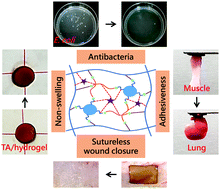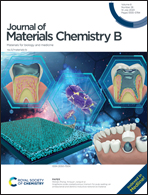An anti-infective hydrogel adhesive with non-swelling and robust mechanical properties for sutureless wound closure†
Abstract
A non-swelling hydrogel adhesive is urgently needed in clinical application for wound closure; however, preparing a non-swelling hydrogel adhesive with superior mechanical and tissue adhesion properties remains a challenge. In this study, we developed a new family of non-swelling hydrogel adhesives composed of Pluronic F127 diacrylate, poly(ethylene glycol) diacrylate, modified sodium alginate, and tannic acid. Physical and biological properties of the hydrogels were systematically evaluated in vitro/vivo. The results indicated that the hydrogels exhibited non-swelling features, robust mechanical properties and good adhesion abilities toward various tissues. The hydrogels also exhibited good cytocompatibility and strong antibacterial activities against S. aureus and E. coli. Additionally, the hydrogel could be used for sutureless wound closure and displayed better advantages compared to sutures and commercial adhesive pads. The above results demonstrated that our non-swelling hydrogel adhesive with robust mechanical properties holds great promise for applications in clinical surgery.

- This article is part of the themed collection: Journal of Materials Chemistry B Lunar New Year collection 2021


 Please wait while we load your content...
Please wait while we load your content...